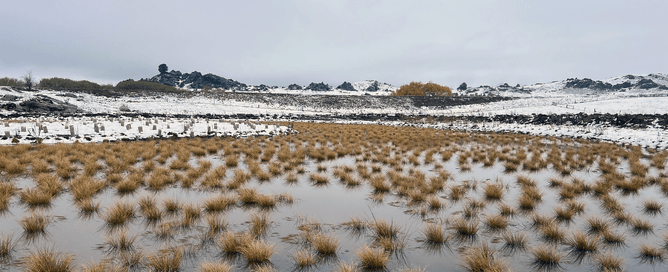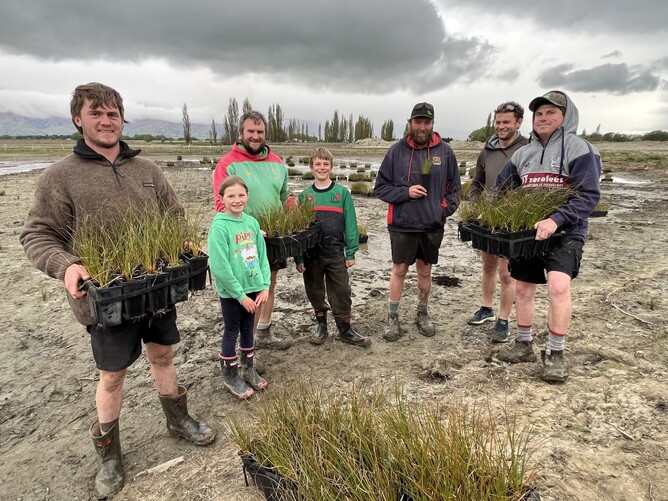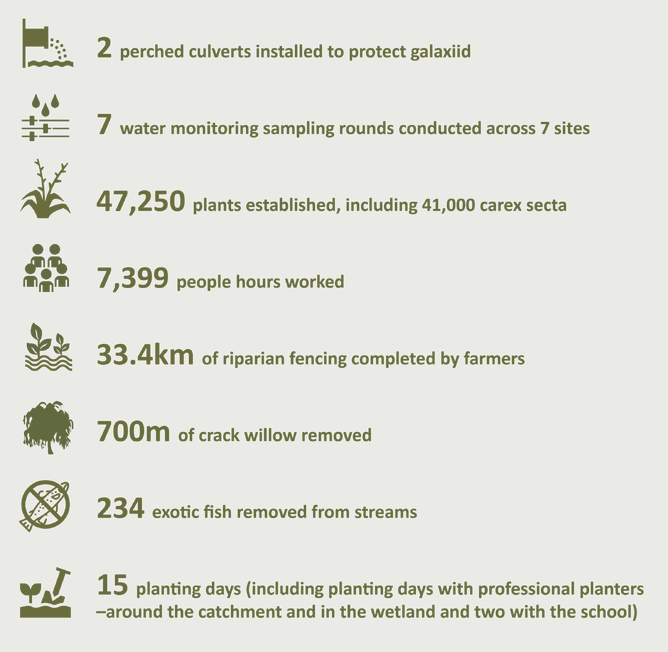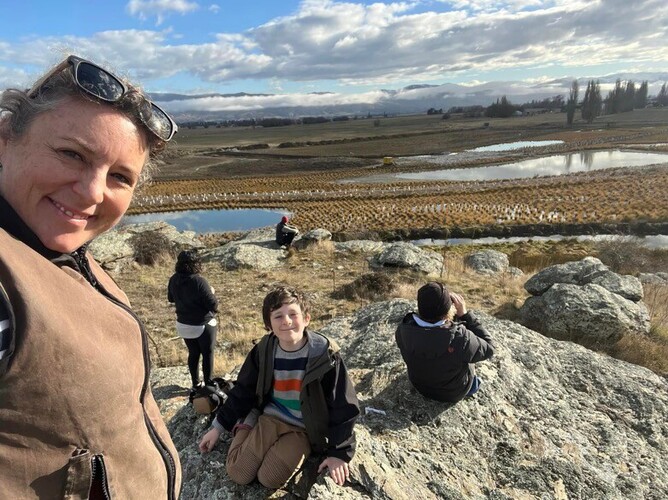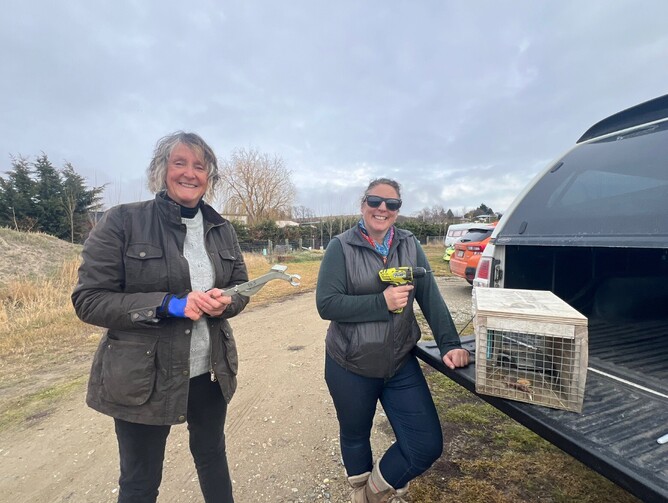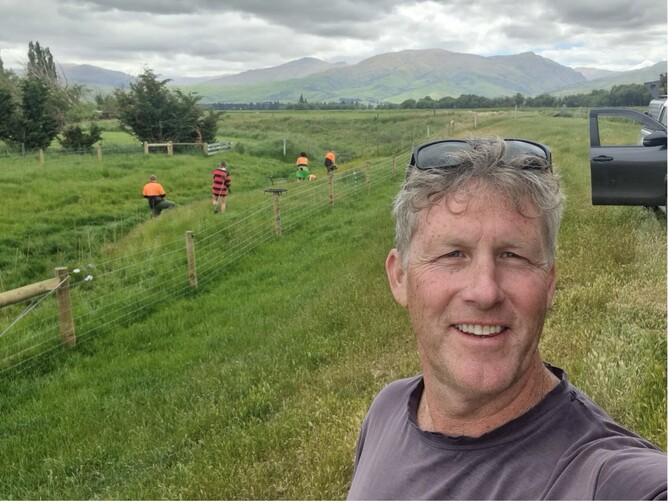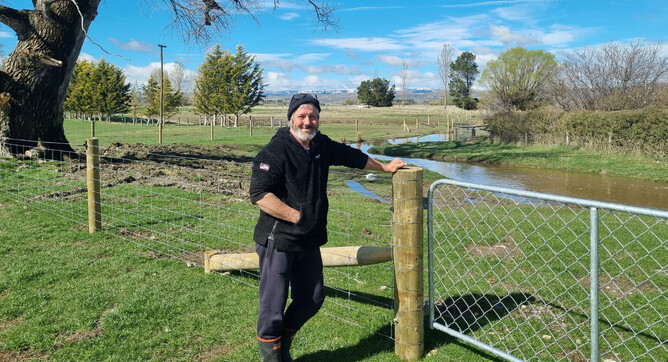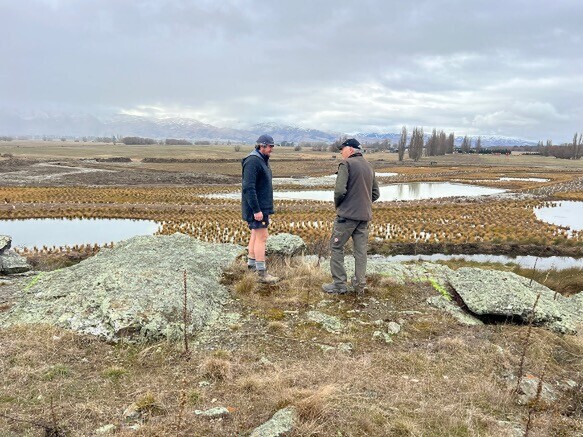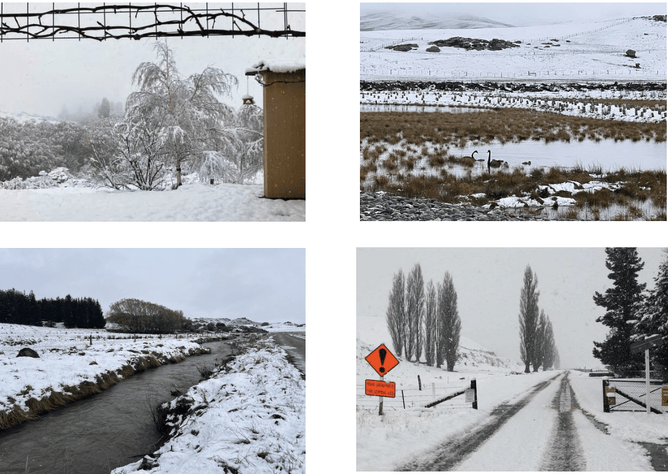As we move into the final stretch of the year, we’ve had a reminder of how unpredictable spring can be. Mid September brought a sudden turn in weather, with hot sunny days giving way to snow and floods. Our thoughts are with our resilient farming community, who continue to adapt and respond to often challenging weather conditions. Despite these disruptions, it’s been a productive few months for the Thomsons Catchment Project. Our visits to farms upstream from the wetland have provided valuable insights into the ongoing efforts by local farmers to protect and improve their creeks.
Year 2 of our project has been marked by significant achievements, from extensive riparian fencing and native plantings to successful community planting days and critical pest control activities. Our dedicated bird monitoring group has been keeping a close watch on local wildlife, while our new predator and pest control group is already making strides in safeguarding our wetland ecosystem.
In this issue, we cover some exciting developments, including the launch of a new factsheet on protecting our unique galaxiids, details on an upcoming community planting day, and progress on new walking access to the wetland. Read on to learn more about these initiatives and how you can get involved.
We have our next community wetland planting day on Sunday 29 September, from 10am to 12 noon, so please join us and get involved in a variety of activities that will help protect and enhance our wetland. More details in the newsletter.
We’re grateful for the continued support and enthusiasm from you – our community and partners – as we work together to make a positive impact. Stay tuned for more updates.
One of the Year 2 highlights was our wetland planting. In October 2023, the Matakanui Combined Rugby Football Club crew lent a helping hand, moving plants into the wetland and making a real difference.
What’s been happening
Celebrating Our Year 2 Achievements
It’s been just over two years since the Thomsons Catchment Project kicked off, and what an incredible journey it’s been! We’re very excited to celebrate the progress we’ve made in improving water quality and fostering a healthier ecosystem in our catchment. Our project, driven by local farmers, has seen significant milestones achieved in Year 2, making a real difference for our environment.
Key Stats
Over the past year, we’ve expanded our riparian fencing efforts, planted thousands of native plants, and continued to monitor water quality throughout the catchment.
In collaboration with NIWA, we hosted a well-attended wetland workshop, and the ongoing removal of invasive species like crack willows has made a noticeable impact. The project’s wetland area saw extensive planting, contributing to both habitat restoration and improved water filtration.
Our school partnerships have also grown, with students participating in planting days and water quality monitoring. We’ve seen great engagement from the community, with 15 planting days and countless volunteer hours dedicated to supporting our work. The installation of perched culverts and further protection for native fish species shows our commitment to preserving local biodiversity.
Looking ahead, we have exciting plans in place for Year 3, including further pest control efforts, planting at new sites, and continued wetland restoration. Please stay connected and follow our progress at www.mcg.org.nz/thomsons-project and on our Facebook page.
Thank you to everyone who has contributed to the project’s success so far. Together, we’re making a tangible difference in protecting and enhancing the Thomsons catchment for future generations.
Bird Monitoring Group Keeping Watch on Wildlife
Our bird monitoring group has been hard at work over the past few months, heading out in mid-August to track the birdlife in our wetland. We’ve had some exciting sightings! The elusive black-billed gulls made a brief appearance, and our resident swans hatched four beautiful cygnets in early August.
The group meets regularly to monitor and record vital data on bird populations, providing important insights into the health of our wetland's birdlife. If you're free to join us for the next session, we'd love to have you there – everyone is welcome! We'll be meeting on Friday 27 September at 9 am on Alton St, Omakau, at the entrance to the rail trail.
If you'd like to get involved with bird monitoring, reach out to Nicola on 0274939500 or keep an eye on the Thomsons Project Facebook page for updates and photos from our monitoring sessions. We'd love for more keen eyes to join us in this important work.
Kim Hore and son Jack out with the bird monitoring crew mid August.
Protecting Our Wetland
A new chapter in wetland protection is underway with the formation of our wetland predator and pest control group, which came together after a first meeting on 9 August. A great turnout of enthusiastic locals has already seen the group place monitoring cards around the wetland, with early signs showing some mice and rat activity, but fortunately, no evidence of stoats or ferrets so far. Some of our enthusiasts are starting their own predator programmes on their own properties.
We’re grateful for the support from DOC’s Dave Goodman, who not only reviewed our predator control plan but also attended our first meeting and provided invaluable advice from his many years of experience. A special thank you to Jo Wakelin as well, who shared her insights from running a similar predator control initiative at the top of Lake Dunstan, offering plenty of practical tips to help get us started.
We’re looking forward to seeing this group grow and make a real impact on protecting our wetland and its wildlife.
Jo Wakelin showing Pest Group lead Kim Hore some of the practical tools her group uses.
An update from Kim Hore, Pest Group lead
Seeing the swans start nesting has really spurred us on to focus on protecting the wildlife moving into the wetland. In mid-August, we gathered to install predator monitoring gear to assess the situation. This included ink tunnels baited with “eggselent” lure and chew cards preloaded with peanut butter. After setting these up, we left them for about 10 days before returning with an even larger volunteer group of seven to check the results. Also joining us was Alexia from the Central App, who was keen to report on the findings.
We observed some activity in most of the ink tunnels and a few nibbles on the chew cards. Mostly, we found evidence of mice, although one tunnel showed signs of a rat. We are logging all of our monitoring station locations and data in TrapNZ to track results over time and identify any hot spots.
It's good news for the birds, as it appears that predators have not yet moved in—great to think we’ve kept them out so far! We have 10 DOC 250 traps on the way, which will help protect the nesting birds from rats, stoats, ferrets, and hedgehogs. Once they arrive, we'll get together to set them up and install them at the wetland. Going forward, these traps will need to be checked weekly, so if anyone is interested in helping with this, please let us know.
Farmers Prepare for Galaxiid Habitat Planting
Farmers have been hard at work, spraying select areas along the creeks in preparation for a significant planting effort in late September. These sites have been carefully chosen for their importance to the local galaxiid populations, small native fish that rely on cool, shaded waters to thrive.
The planting will focus on native species that provide much-needed shade over the water, helping to maintain cooler temperatures and improve habitat conditions for galaxiids.
As these plants grow, they will also contribute to the ecosystem by supporting biodiversity, providing a natural food source (small insects and bugs), and enhancing the overall health of the waterway.
We also have a native planting list on our website if you would like a guide on what plants work best along waterways.
Haines Battrick with the planting team at one of the galaxiid sites last November
– we are looking forward to planting more sites at the end of the month.
Fencing and Planting Progress
We’re thrilled to showcase the fantastic fencing and planting work happening throughout the catchment. A big thanks to Matt O’Malley for his enthusiasm and getting involved.
“What a great project, I’m really happy to be involved with it,” says Matt. “I can’t wait to get some more plants in and see the newly fenced off area develop.”
Thank you to everyone contributing to these vital efforts!
New Factsheet: How to Protect Our Unique Galaxiids
The ‘How to Protect Our Central Otago Roundhead Galaxias’ factsheet is now available on our website. This factsheet is designed for landowners and farmers with waterways running through their land to help with some simple and practical tips to protect these nationally endangered fish, which are only found in this region.
Whether you're keen to learn about creating habitats, managing weeds, or understanding the threats facing these unique species, the factsheet is a handy guide for landowners and community members alike.
Here are a few key takeouts:
Habitat: Central Otago roundhead galaxiids are typically found in cool, gravel-bottom streams throughout the Manuherekia and Taieri catchments, between 350m and 800m above sea level. They are also present in some weedy drains that offer protection from predatory fish.
Threats: Major threats include habitat degradation, predation by trout and perch, and invasive pests. The species has experienced a 50% population decline over the past 25 years.
Protect vegetation: Restore and maintain riparian vegetation along stream banks. Native plants like Carex secta provide shade and reduce sediment runoff, benefiting galaxiids and their food sources.
Avoid habitat disruption: Refrain from excavating natural springs or straightening small creeks, which are crucial habitats for galaxiids. If creek maintenance is necessary, consult experts to minimise impact.
Control weeds carefully: If managing watercress and other weeds, consider methods that minimise disturbance to the creek bed and avoid widespread chemical use, which can harm galaxiids.
Not sure if you have galaxiids in your creek and want to find out. Give Nicola McGrouther a call on 02749839500 and she can help.
Visit www.mcg.org.nz/thomsons-project/ to check out the factsheet.
What’s next: the wetland
New Walking Access to Wetland in the Works
We're pleased to announce that we’re developing new walking access to our wetland! Thanks to the expertise of Andrew Kerr from The Breen Construction Company and engineer Brendan Sheehan, we’re exploring a route from the rail trail to a scenic hill overlooking the wetland. This new access will offer a fantastic vantage point to appreciate the area’s natural beauty.
We’re also grateful for the support of the Central Rail Trail Trust and DOC, whose assistance is crucial in making this project a reality.
Keep an eye out for updates—our goal is to have this new access in place by March next year. We look forward to offering a new way for the community to engage with and enjoy the wetland.
This is all part of a longer-term vision to provide public access to the wetland, with a boardwalk that goes all the way round for local people to enjoy a beautiful and easy walk, enjoying this community asset.
For more information or updates, stay tuned to our Facebook page.
Andrew Kerr and Roger Williams investigating sites for wetland access during August.
Join us for a Community Planting Day at Thomsons Wetland
We’re excited to invite you to a hands-on community planting day at Thomsons Wetland as part of the ongoing efforts to restore this vital ecosystem. Come along on Sunday 29 September, from 10am to 12 noon, and get involved in a variety of activities that will help protect and enhance our wetland.
What’s in store:
Plant native species along the wetland edges.
Search for and remove small willow seedlings.
Help cut back exotic weeds on the dry hills around the wetland.
What to bring:
No experience is necessary, and there are plenty of tasks for all ages and abilities. Bring your gumboots and gardening gloves (and a spade if you have one) and get ready to make a difference. A BBQ lunch will be provided – a well-earned treat after getting our hands dirty.
Meeting point and directions:
We'll meet at Omakau Domain at 9:45am sharp, where we will carpool in a convoy to the wetland site. This ensures we can manage parking carefully, especially if it’s wet.
Register now!
Please let us know you're coming by emailing thomsonscatchment@gmail.com. We want to make sure we have enough food for everyone and can keep you updated if the weather turns.
This is a fantastic opportunity to connect with others in the community, get outdoors, and contribute to a project that will benefit our environment for years to come. Everyone is welcome – we can’t wait to see you there!
Note: If the weather is bad on the day, we’ll postpone the event, so be sure to register and leave your details so we can keep you in the loop.
